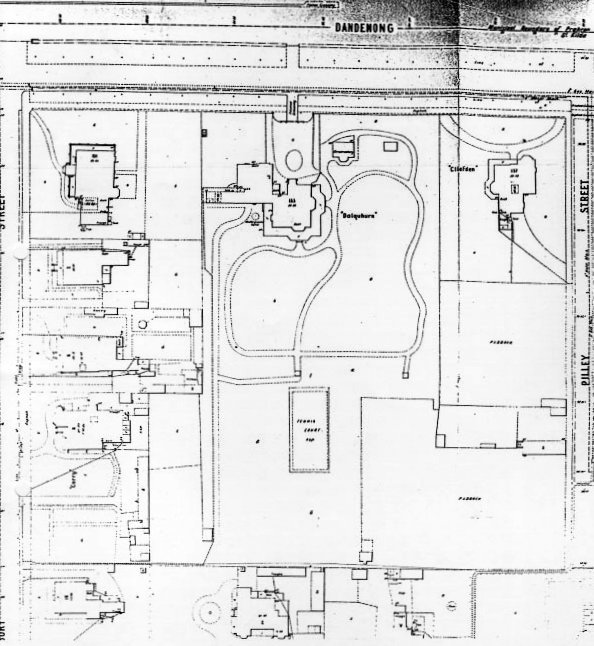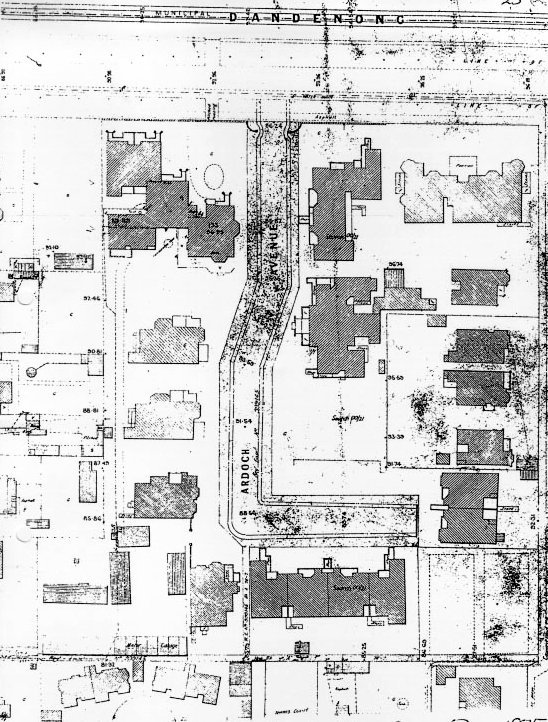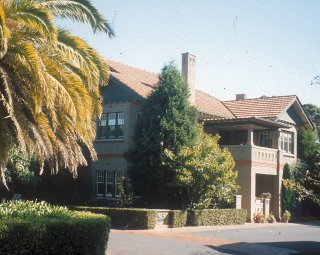|
|
|
Home | Introduction | Contents| Feedback | Map | Sources | Glossary |
|
31
Ardoch (former Dulquhurn, later Ardoch Education Centre)
Ardoch is unlike any other flat development in
Each building has its own identity within the tradition of the English Garden Suburb movement and the English Arts and Crafts architectural style. It was the first time that the grounds of a large nineteenth century house were enlarged and colonised by apartment buildings, the predecessor of the process so familiar today.
The land was subdivided for sale in 1857 as
Crown Portions 148B and 154A acquired by John Cook and W. Jones respectively. A
13-roomed two-storied Italianate house Dulquhurn was
built for £225 in 1864. Its first owner was the important architect William
Wilkinson Wardell (1823-99), who moved there from
MMBW Detail Plans for Dulquhurn and Cliefden, 1897 Wardell designed four
significant churches in
Once in
Wardell lived five years at
Dulquhurn until 1869 when it was sold to Edward Keep
and Wardell moved to
Wardell’s architectural legacy stems from a cultured mind and a devotional spirit. His known buildings and projects testify to his scholarship and lively interest in contemporary architectural practice... the remarkable quality of his buildings... functionalist in their planning, structurally sound, commendable in their attention to massing and bulk, visually pleasing in their proportions, and notable for their considered and beautifully executed details.
Four years later,
Dulquhurn was extended to 16 rooms by its next owner, William Wilson,
another person whose names conveniently begin with W! That year, a 12-roomed
house Cliefden, went up next door to the east, for
John Spence, merchant. A survey plan shows the lavish landscaping of
Dulquhurn, in 1897 with front turning circle flower
bed, conservatory, tennis court, sweeping serpentine paths, to the west a
ballroom (?) wing and to the south-east a large horse-paddock and stables on
Alex Younger (c1882-1952/53) was brought up in
Coldstream and later lived in
During the 1920s, he converted mansions into
guesthouses, flats and rooming houses, including Nangunia
(or Charterfield, Charles Webb was architect),
MMBW Ardoch Plans, 1935 The layout and design of
Ardoch is generally in an English Arts and Crafts and Bungalow manner. The
composition appears to be influenced by innovative English urban design, such as
Hampstead Garden Suburb, laid out in 1907 by Sir Raymond
Unwin of Parker & Unwin.
Unwin also planned Letchworth Garden Suburb (1904) also north of
Younger extended Ardoch (house) to achieve six
self-contained flats, each with separate entries. He inserted
Typical Ardoch bungalow, 2002 In 1924,
Cliefden was bought by
Buildings B2 and B5 also appear to be
1928-38. In 1951-54, the security and convenience of a caretaker’s flat was
added, with garages. But in 1949, the CML Assurance Society Limited purchased
Ardoch as well as the three separately owned bungalows in
From 1930, Dr Herbert Vere Evatt (1894-1965) and his wife, Mary Alice (‘Mas’) Evatt (1898-1973), kept a flat at Ardoch. Evatt was then a judge in the High Court of Australia. He had been Attorney General and Minister for External Affairs in Prime Minister John Curtin’s Labor war-time government, Deputy Prime Minister in the Ben Chifley government and became President of the United Nations. Mas Evatt was a distinguished Australian artist. Ballarat Regional gallery mounted an important retrospective exhibition of her work in 2002. Their apartment was furnished with Fred Ward designs and her own art collection. She was curious about all forms of contemporary art, and used their frequent travels overseas to pursue that interest. In June 1977, in an imaginative government gesture, the property of 53 flats in 2.8 hectares was bought by the Victorian Education Department as a secondary school for 350 pupils. The stables and bungalows were demolished for temporary classrooms. The Department’s intention was for a ‘homely’ domestic atmosphere for the school, particularly for disadvantaged children, including a homeless children’s programme. Building B2 remained flats, to retain a liveliness on the site after hours. The Department Regional Office occupied B1, B3 and B10 and the school was in B4-B9. The school was praised as ‘reaching out to disadvantaged and...difficult children’. Historian Gillian Upton recalls singing as she entered the gate each morning. Barde Gregory, now a successful architect, was a student at Ardoch: It would be hard to imagine any different to the indelible effect the Ardoch environment had on students, teachers and visitors alike. Classes in the Townhouses, play and relaxation in the gardens and lawns contributed greatly to the informal and caring approach the school arrived for. In 1992, the Kennett government’s ‘rationalisation’ closed the school, relocating pupils to Windsor Secondary College Campus. Ardoch was added to the Victorian Heritage Register in 1993. It was picked up by the Urban Land Authority. It has now reverted to privately owned apartments. With a venture partner, it was refurbished and expanded to comply with heritage permit conditions, for a satisfying profit.
References
‘
Boyd, Melissa.
Mary Alice Evatt. Mas.
1898-1973.
Cherry, Bridget
& Pevsner, Niklaus.
de Jong,
Dr Ursula M..
‘William
Wilkinson Wardell (1823-1899). An English Architect in the
Extra.
The Age.
Fam,
Lisa. ‘The Lives of Ardoch.
Snapshots of a Changing Community. Margins, Memories
and Masters Project’. City of
Freestone,
Robert. Model Communities.
The Garden City Movement in
Gregory,
Barde, Architect. Fax to Richard Peterson,
Heritage
McCann, Joy. Ardoch Education Centre, Report for the Historic Buildings Council. February 1993.
Peck,
Robert., von Hartel
Trethown.
Henshall Hanson Associates.
City of
Stevens, John.
‘From Fringe to Main Player. The Urban Land
Authority has undergone a dramatic change in its approach and
|
|
St Kilda Historical Society Inc. © 2005 |



